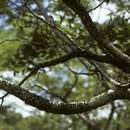en
names in breadcrumbs


The family Apodanthaceae comprises about 10 species[1] of endoparasitic herbs. They live in the branches or stems of their hosts (as filaments similar to a fungal mycelium), emerging only to flower and fruit. The plants produce no green parts and do not carry out any photosynthesis (that is, they are holoparasitic). There are two genera: Pilostyles and Apodanthes.[2] A third genus, Berlinianche, was never validly published.[3] Mitochondrial and nuclear DNA sequences confidently place the Apodanthaceae in the Cucurbitales, where they also fit well in terms of their flower morphology.[4]
The family Apodanthaceae comprises about 10 species of endoparasitic herbs. They live in the branches or stems of their hosts (as filaments similar to a fungal mycelium), emerging only to flower and fruit. The plants produce no green parts and do not carry out any photosynthesis (that is, they are holoparasitic). There are two genera: Pilostyles and Apodanthes. A third genus, Berlinianche, was never validly published. Mitochondrial and nuclear DNA sequences confidently place the Apodanthaceae in the Cucurbitales, where they also fit well in terms of their flower morphology.